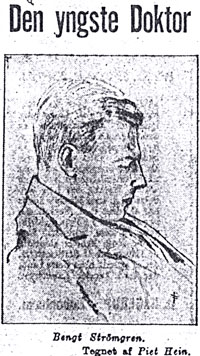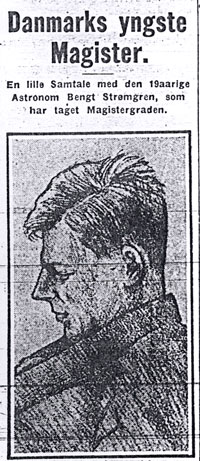The Mecca of quantum physics in Copenhagen
The research environment at Blegdamsvej is singled out in several places as being especially creative and stimulating for those working there - one speaks of "the creative Copenhagen" in the 1920s and 30s.

This has been attributed to the person and the leader Niels Bohr as the stimulating facilitator of creative behaviour and open dialogue. Bengt Strömgren was a part of this milieu for several years and that had a significant influence on his life in science.
The 1920s were the years of development for the new quantum mechanics, including among others, Bohr, Werner Heisenberg and Wolfgang Pauli, which to a great extent unfolded at UITF (Institute for Theoretical Physics, presently the Niels Bohr Institute) in Copenhagen.
During his study at the Polytechnical College and UITF Bengt Strömgren followed the development of the new physics through lectures and symposiums including those by Bohr, Heisenberg, Oskar Klein and Hendrik Kramers.
For example, in 1927 he witnessed Heisenberg's first presentation of the famous uncertainty principle, which presented the impossibility of being able to determine with precision, for example, both the position and velocity of a particle simultaneously.
Inspiration for a creative study environment
Bengt Strömgren experienced the study milieu and for him it was the numerous lectures and teachers which motivated him to make an important choice.

The majority of astronomers in Denmark were working with traditional, classical astronomy - that is to say, the determination and measurement of the positions and luminosity of stars, observations of comets, planets and other celestial phenomena. But Bengt was equipped to combine the results from the new quantum mechanics with astrophysics, the study of the physics of stars. A choice he was determined to follow.
Doctoral dissertation at the age of 21
After only two years of intensive university study Bengt Strömgren received his MSc degree in astronomy and nuclear physics and was now ready to begin his research education in astronomy.
Even though he had already decided to enter a new and unknown land, the application of quantum mechanics in astrophysics, his Ph.D. work was a selection of classic calculations of comet orbits with the help of numerical methods.
As a 21 year old his doctoral dissertation was accepted and he soon received the opportunity to pursue his project.
Bengt Strömgren (1908-1987)
 Bengt Strömgren photographed on the occasion of receiving his Ph.D. degree at the age of 21.
Bengt Strömgren photographed on the occasion of receiving his Ph.D. degree at the age of 21.
